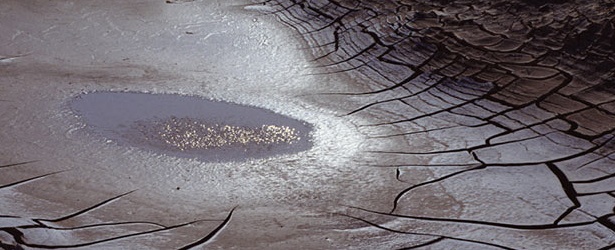California sinking one foot each year from groundwater depletion

The drought-stricken state of California is sinking into itself at an alarming rate, suggests a new report by the U.S. Geological Survey (USGS). The continued over-pumping of groundwater in many parts of the state — the direct result of a historic three-year dry spell — is creating empty pockets of earth that are causing the ground to literally drop, in some places by as much as one foot per year.
The Coachella Valley in Southern California, explains the report, saw surface declines of between 9 inches and 2 feet between 1995 and 2010. Increasing water demand combined with minimal rainfall and recharge throughout the area have created conditions in which underground aquifers are running completely dry, leading to infrastructure damage that's affecting roads, businesses and residences.
Efforts to mitigate the problem in some areas are having a minimally positive effect, admits the report. But groundwater levels "continue to decline to record-low levels in some areas of the valley, and therefore, the magnitudes and rates of land subsidence documented by this study can be expected to continue."
Water district pond projects helping some, but water supply still an issue throughout state
The fifth in a series of USGS studies on land subsidence, this latest report is an eye-opener into the water supply issues that California continues to face. Much of the area where the ground is sinking relies on water coming in from the Colorado River, which is no longer supplying the amounts needed due to drought.
For much of the rest of the state, underground aquifers are key sources of water that, like the Colorado River, are rapidly running dry. Without adequate rains, the most populous state in the country consumes more water than gets replenished naturally, which is resulting in drastic measures being taken to preserve this precious resource.
Beginning in 2009, the Coachella Valley Water District (CVWD), working alongside the USGS, initiated a program to help recharge depleted groundwater in certain areas by establishing a series of ponds that feed in from the Colorado River. These ponds have reportedly helped reduce subsidence rates in some areas.
But in other areas, such as the San Joaquin Valley in the central part of the state, the situation is much more dire. The bread basket of America, California's Central Valley is a water-intensive agricultural region that has been pumping groundwater for agriculture for years, at rates that exceed the amounts going back in naturally.
Without water in California, millions will suffer and food shortages will become new norm
It's obvious that such a scenario cannot persist forever. Either the rains will somehow come and restore what has been lost from years of water overuse — this prospect doesn't look too promising in the near future — or millions of people in the Southwest will have to relocate to other areas of the country where water is more widely available.
"[T]he 'water security of the Colorado River basin' is an important concept, if you are one of the 40 million people who rely on the Colorado River for drinking water, a group that includes residents of Las Vegas, Los Angeles, Phoenix, Tucson, and San Diego," wrote Tom Philpott for Mother Jones.
"Or if you enjoy eating vegetables like broccoli, cauliflower, and spinach during the winter. Through the many diversions, dams, canals, and reservoirs the river feeds as it snakes its way from the Rockies toward Mexico, the Colorado also provides the irrigation that makes the desert bloom in California's Imperial Valley and Arizona's Yuma County–[the] source of more than two-thirds of US winter vegetable production."
Sources for this article include:
http://www.desertsun.com
http://www.dailymail.co.uk
http://science.naturalnews.com
Source: NaturalNews
Written by Jonathan Benson

Why don’t they use the ocean water and take the salt out.
Isn't it the groundwater that is being re-directed for upcoming development projects behind the 60-yr water scam? They did not foresee a REAL water shortage on the one they created – this is tragic.